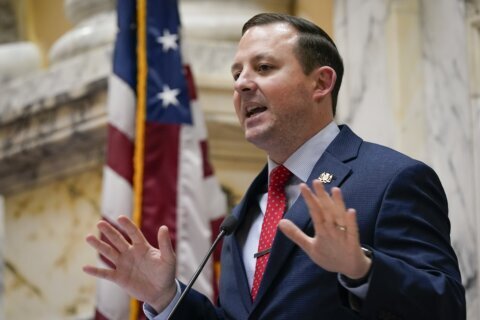This article was republished with permission from WTOP’s news partners at Maryland Matters. Sign up for Maryland Matters’ free email subscription today.
Vaping among high school students in the U.S. fell sharply from 2023 to 2024, a trend that was mirrored in Maryland but at a slower pace, according to health advocates and state officials.
Data released Thursday by the U.S. Centers for Disease Control and Prevention showed that about 1.63 million middle and high school students regularly used e-cigarettes this year, or 5.9% of students surveyed for the 2024 National Youth Tobacco Survey. That is about 500,000 kids fewer than the year before, when 2.13 million kids reported using e-cigarettes in the previous 30 days.
The biggest drop came among high school students: 10% of them reported using e-cigarettes in 2023, but that number fell to about 7.8% of high school students in 2024, the data shows.
The CDC said in a statement on the release of the data that “the number of youth who used e-cigarettes in 2024 is approximately one-third of what it was at its peak in 2019, when over 5 million youth reported current e-cigarette use.”
While it does not have year-to-year numbers, Maryland has seen similar results in recent years, according to Chase Cook, communications director for the Maryland Department of Health.
“During the 2022-23 school year, 15.9 percent of Maryland high school students used tobacco products with 14.3 percent reporting electronic smoking device use,” he said in a written statement Thursday. “This represents an overall decrease from the 2018-19 school year when ESD rates in Maryland high school students peaked at 23 percent.”
Cook added that the results look promising, but there is more work to be done.
“We are encouraged by the decreasing rates and will continue working with partners to further reduce consumption,” Cook said.
That was echoed by Erika Sward, spokesperson for the American Lung Association, who said there are still too many teenagers using e-cigarettes, which can lead to known health consequences for adolescents down the line.
“There was a high of 5.4 million youths using e-cigarettes (in 2019), and the latest study shows that we are down to 1.6 million regular users,” she said. “That is still 1.6 million regular users too many.”
With vaping products still relatively new on the market, Sward said that health officials still do not know the long-term effects e-cigarettes can have on youths and on public health.
“We know that in the short term, any exposure to nicotine among young adults and adolescents alters one’s brain permanently — can lead to greater problems similar to ADHD (attention-deficit/hyperactivity disorder) in terms of focusing and the short-term memory ability,” she said.
“We also know that inhaling the kind of chemical cocktail that e-cigarettes have into one’s lungs is extraordinarily dangerous,” Sward said. “But the long-term consequences of the exposure of these chemicals is unknown — they’ve been on the market for about 15 years.”
She pointed to Maryland as one of the “most responsive and responsible” states regarding policies and actions to help curtail e-cigarette use among students.
“States like Maryland … some of the policies that the General Assembly passed last year is really important for all of that,” she said. “Maryland has been one of the most responsive and responsible at implementing the policies that we know will work.”
One law that took effect this month is the Tobacco Retail Modernization Act, which prohibits convenience stores and gas stations from selling e-cigarettes, allowing sales only by licensed vape shop vendors, along with other regulations. Sen. Benjamin Kramer (D-Montgomery), who sponsored the legislation, said earlier this year that his goal was to help tackle the “epidemic of youth vaping in our state.”
Sward said there are other reasons that teen vaping has gone down nationally over the last few years, such as stronger federal enforcement against those who sell illegal vaping products and bans on most flavored e-cigarettes, which “eliminates a lot of the attractiveness for kids.”
“Other tried and true measures: educating youth about these products through mass media campaigns,” she said. “Taxing e-cigarettes … also making sure that we’re helping people who are addicted to tobacco and nicotine get the help they need to quit.”
“There is no silver bullet that takes care of everything when it comes to tobacco use,” she said.







